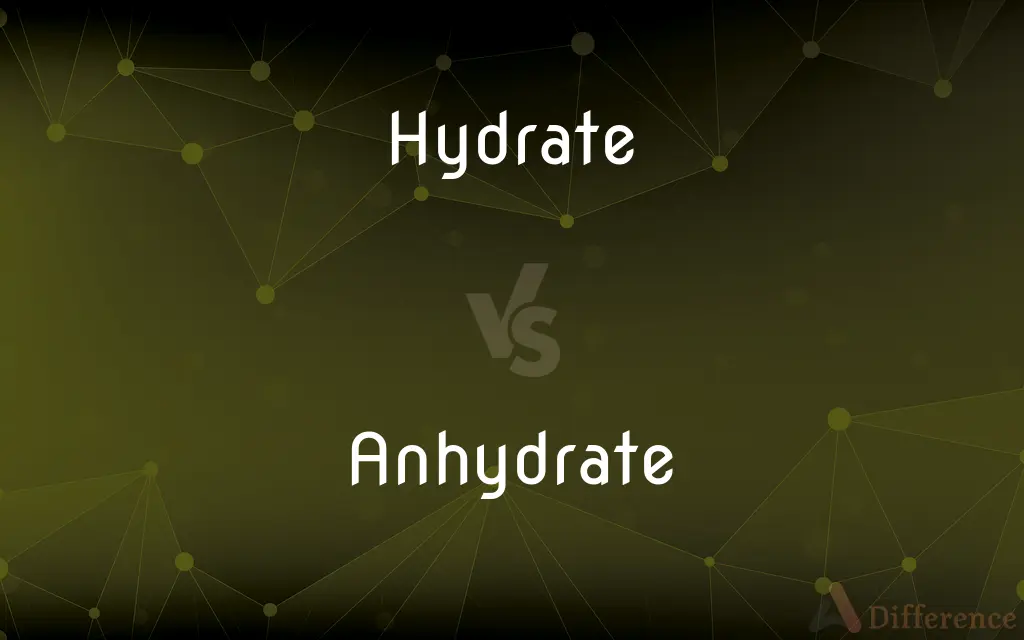Hydrate vs. Anhydrate — What's the Difference?
By Urooj Arif & Fiza Rafique — Updated on March 20, 2024
Hydrates contain water molecules in their structure, crucial for their formation and properties, while anhydrates lack water, affecting their stability, reactivity, and uses.

Difference Between Hydrate and Anhydrate
Table of Contents
ADVERTISEMENT
Key Differences
Hydrates are chemical compounds that incorporate water molecules into their molecular structure, either in a fixed ratio or loosely bound. This inclusion of water is essential for the physical properties and stability of the compound. On the other hand, anhydrates are the counterparts that do not contain water molecules in their structure, often resulting from the dehydration of hydrates.
The presence of water in hydrates plays a crucial role in determining their solubility, melting point, and reactivity. These compounds are often found in natural settings, such as minerals, and in synthetic products like pharmaceuticals. Whereas anhydrates, lacking water, tend to have different solubility patterns, higher melting points, and can exhibit greater stability under certain conditions.
In industrial and laboratory settings, the conversion from hydrate to anhydrate form (and vice versa) is a common process, leveraging the differences in physical and chemical properties for specific applications. For example, hydrates may be preferred in applications requiring lower reactivity, while anhydrates might be used where moisture sensitivity is a concern.
The formation of hydrates can significantly impact the storage and handling of chemicals. Hydrates require conditions that prevent the loss of water to maintain their structure and functionality. Conversely, anhydrates are often easier to store and handle because they do not depend on water content for their stability, making them more resilient to changes in environmental conditions.
The study of hydrates is particularly important in fields like geology and environmental science, where they can indicate the presence of water in minerals or play roles in natural processes. Anhydrates, being the dry form, are studied for their potential in dry environments and in processes requiring the absence of water to proceed efficiently.
ADVERTISEMENT
Comparison Chart
Water Content
Contains water molecules in its structure.
Lacks water molecules in its structure.
Physical Properties
Lower melting points, specific solubility patterns.
Higher melting points, different solubility.
Stability
Stability depends on water content.
Generally more stable in absence of water.
Applications
Used where water content is beneficial.
Used in dry conditions or where moisture sensitivity is a concern.
Conversion
Can be dehydrated to form anhydrates.
Can be hydrated to form hydrates.
Compare with Definitions
Hydrate
Found in nature and synthetic materials, affecting properties.
The hydrate form of a drug may offer improved solubility.
Anhydrate
Results from the dehydration of hydrates.
Heating gypsum produces anhydrite, used in drywall.
Hydrate
Requires specific conditions to retain water molecules.
Hydrate storage conditions must prevent water loss.
Anhydrate
A substance that lacks water in its composition.
Anhydrous copper sulfate is white, indicating absence of water.
Hydrate
A compound containing water molecules bonded to its structure.
Copper sulfate pentahydrate turns blue when hydrated.
Anhydrate
Preferred in moisture-sensitive applications.
Anhydrous chemicals are essential in moisture-sensitive chemical syntheses.
Hydrate
Used in chemistry to denote compounds formed with water.
Gypsum, a common hydrate mineral, is used in construction.
Anhydrate
Offers different physical properties than its hydrate form.
Anhydrous salts often have higher melting points.
Hydrate
Involved in geological and environmental processes.
Methane hydrates in ocean floors are potential energy sources.
Anhydrate
Studied for applications in dry environments.
Anhydrous compounds are researched for desert agriculture.
Hydrate
In chemistry, a hydrate is a substance that contains water or its constituent elements. The chemical state of the water varies widely between different classes of hydrates, some of which were so labeled before their chemical structure was understood.
Anhydrate
(organic chemistry) An acid anhydride
Hydrate
A compound, typically a crystalline one, in which water molecules are chemically bound to another compound or an element.
Anhydrate
(chemistry) The anhydrous form of a normally hydrated compound
Hydrate
Cause to absorb water
A powerful moisturizer that hydrates the skin for up to twelve hours
Anhydrate
To dehydrate, especially in food processing.
The Tarim mummies, found in present-day China, were anhydrated naturally by searing desert conditions.
Hydrate
A solid compound containing water molecules combined in a definite ratio as an integral part of the crystal. Often used in combination
Pentahydrate.
Hydrate
To rehydrate.
Hydrate
To supply water to (a person, for example) in order to restore or maintain fluid balance
"Cold water is the fastest and safest way to hydrate an ordinary athlete" (Jane E. Brody).
Hydrate
To become a hydrate.
Hydrate
(chemistry) A solid compound containing or linked to water molecules.
Hydrate
Water.
Hydrate
(transitive) To take up, consume or become linked to water.
A lotion can hydrate the skin.
Hydrate
(slang) To drink water.
Hydrate
(programming) To load data from a database record into an object's variables
Hydrate
A compound formed by the union of water with some other substance, generally forming a neutral body, as certain crystallized salts.
Hydrate
To form into a hydrate; to combine with water.
Hydrate
Any compound that contains water of crystallization
Hydrate
Supply water or liquid to in order to maintain a healthy balance;
The bicyclists must be hydrated frequently
Hydrate
Become hydrated and combine with water
Hydrate
Cause to be hydrated; add water or moisture to;
Hydrate your skin
Common Curiosities
What distinguishes a hydrate from an anhydrate?
Hydrates contain water in their structure, affecting properties like solubility, whereas anhydrates lack water, often leading to different physical characteristics.
Can an anhydrate become a hydrate?
Yes, an anhydrate can absorb water to become a hydrate, a process that depends on the environmental conditions and the compound.
Why are hydrates important in pharmaceuticals?
In pharmaceuticals, hydrates can offer improved solubility or stability, affecting the delivery and efficacy of the drug.
What is the environmental significance of methane hydrates?
Methane hydrates are a potential energy source, but their study also helps understand climate change impacts due to methane's role as a greenhouse gas.
Are anhydrates more stable than hydrates?
Anhydrates are generally more stable in the absence of water, making them preferable for long-term storage in dry conditions.
How is a hydrate formed?
A hydrate is formed when water molecules are incorporated into the structure of a compound, either during synthesis or through natural processes.
What are the uses of anhydrates?
Anhydrates are used in applications where moisture sensitivity is a concern, in dry environments, or where higher stability is required.
What happens during the dehydration of a hydrate?
Dehydration removes water from the hydrate, often through heating, resulting in an anhydrate form.
What is the impact of hydrates on drug solubility?
Hydrates can significantly impact drug solubility, with some hydrate forms offering better solubility than their anhydrate counterparts.
What role do hydrates play in geology?
Hydrates, especially those found in minerals, can indicate the presence of water in geological formations and are involved in various natural processes.
How does the presence of water in hydrates affect their properties?
Water affects the melting point, solubility, and reactivity of hydrates, often making them distinct from their anhydrate counterparts.
Why are anhydrates preferred in certain chemical syntheses?
Anhydrates are preferred in moisture-sensitive syntheses because they prevent unwanted reactions that water could cause.
How are hydrates and anhydrates identified in the laboratory?
They can be identified through techniques like X-ray diffraction, thermal analysis, and chemical tests that determine water content.
Can all compounds form hydrates?
Not all compounds can form hydrates; the ability to form hydrates depends on the chemical structure and properties of the compound.
How do hydrates affect the handling and storage of chemicals?
The presence of water in hydrates requires specific conditions to prevent water loss, affecting storage and handling protocols.
Share Your Discovery

Previous Comparison
Why vs. Because
Next Comparison
Sing vs. SongAuthor Spotlight
Written by
Urooj ArifUrooj is a skilled content writer at Ask Difference, known for her exceptional ability to simplify complex topics into engaging and informative content. With a passion for research and a flair for clear, concise writing, she consistently delivers articles that resonate with our diverse audience.
Co-written by
Fiza RafiqueFiza Rafique is a skilled content writer at AskDifference.com, where she meticulously refines and enhances written pieces. Drawing from her vast editorial expertise, Fiza ensures clarity, accuracy, and precision in every article. Passionate about language, she continually seeks to elevate the quality of content for readers worldwide.














































